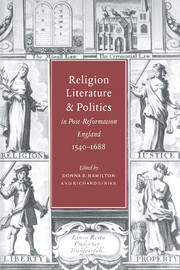Book contents
- Frontmatter
- Contents
- List of contributors
- Introduction
- 1 Sir John Oldcastle as symbol of Reformation historiography
- 2 The “sacred hunger of ambitious minds”: Spenser's savage religion
- 3 Subversive fathers and suffering subjects: Shakespeare and Christianity
- 4 Kneeling and the body politic
- 5 Donne and the politics of devotion
- 6 Catholic, Anglican or puritan? Edward Sackville, fourth Earl of Dorset, and the ambiguities of religion in early Stuart England
- 7 Crucifixion or apocalypse? Refiguring the Eikon Basilike
- 8 Marvell, sacrilege, and Protestant historiography: contextualizing “Upon Appleton House”
- 9 Entering The Temple: women, reading, and devotion in seventeenth-century England
- 10 Contextualizing Dryden's Absalom: William Lawrence, the laws of marriage, and the case for King Monmouth
- 11 Reformation in the Restoration Crisis, 1679–1682
- 12 Shadwell's dramatic trimming
- Index
9 - Entering The Temple: women, reading, and devotion in seventeenth-century England
Published online by Cambridge University Press: 16 October 2009
- Frontmatter
- Contents
- List of contributors
- Introduction
- 1 Sir John Oldcastle as symbol of Reformation historiography
- 2 The “sacred hunger of ambitious minds”: Spenser's savage religion
- 3 Subversive fathers and suffering subjects: Shakespeare and Christianity
- 4 Kneeling and the body politic
- 5 Donne and the politics of devotion
- 6 Catholic, Anglican or puritan? Edward Sackville, fourth Earl of Dorset, and the ambiguities of religion in early Stuart England
- 7 Crucifixion or apocalypse? Refiguring the Eikon Basilike
- 8 Marvell, sacrilege, and Protestant historiography: contextualizing “Upon Appleton House”
- 9 Entering The Temple: women, reading, and devotion in seventeenth-century England
- 10 Contextualizing Dryden's Absalom: William Lawrence, the laws of marriage, and the case for King Monmouth
- 11 Reformation in the Restoration Crisis, 1679–1682
- 12 Shadwell's dramatic trimming
- Index
Summary
Let the woman learn in silence with all subjection. But I suffer not a woman to teach, nor to usurp authority over the man, but to be in silence … Continue in faith and charity and holiness with sobriety.
(I Timothy 2.11–15)These infamous words of St. Paul, which must have formed the authoritative scriptural text for many a misogynist sermon at church and in the home, may serve to remind us of the constraints upon women's access to the word (and the Word) in a period of profound religious sensitivity such as the seventeenth century in England. The essential characteristic of a Christian woman, repeated in consecutive sentences in the Pauline text, is “silence”: a silence representing submission, the silence of one who is “subject” to another's authority, a pupil or learner who is expressly forbidden to teach but must ever increase her holiness. It is interesting to observe how the word “holiness” replaces “hope” in this sober echo, for female consumption, of the more familiar trio of faith, hope and charity from 1 Corinthians 13.13; good works and a holy outlook were apparently more significant than inner confidence when it came to women's spirituality. How, then, was a woman to fulfil the requirements of devotion and femininity in the seventeenth century, as laid down by St. Paul? The most obvious way for a woman to learn in silence was either to listen to a man, or to read.
- Type
- Chapter
- Information
- Publisher: Cambridge University PressPrint publication year: 1996
- 2
- Cited by

